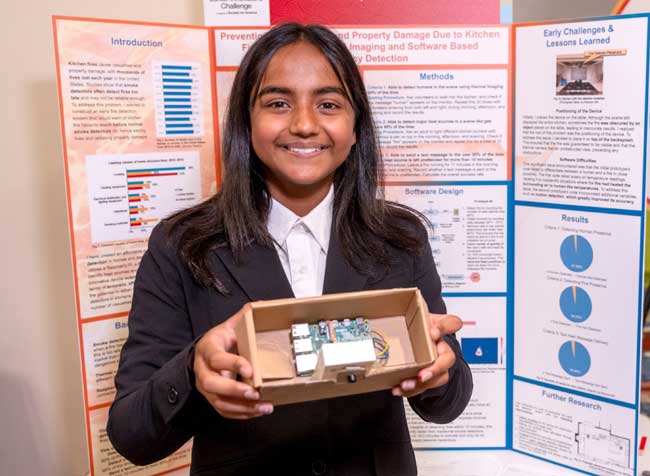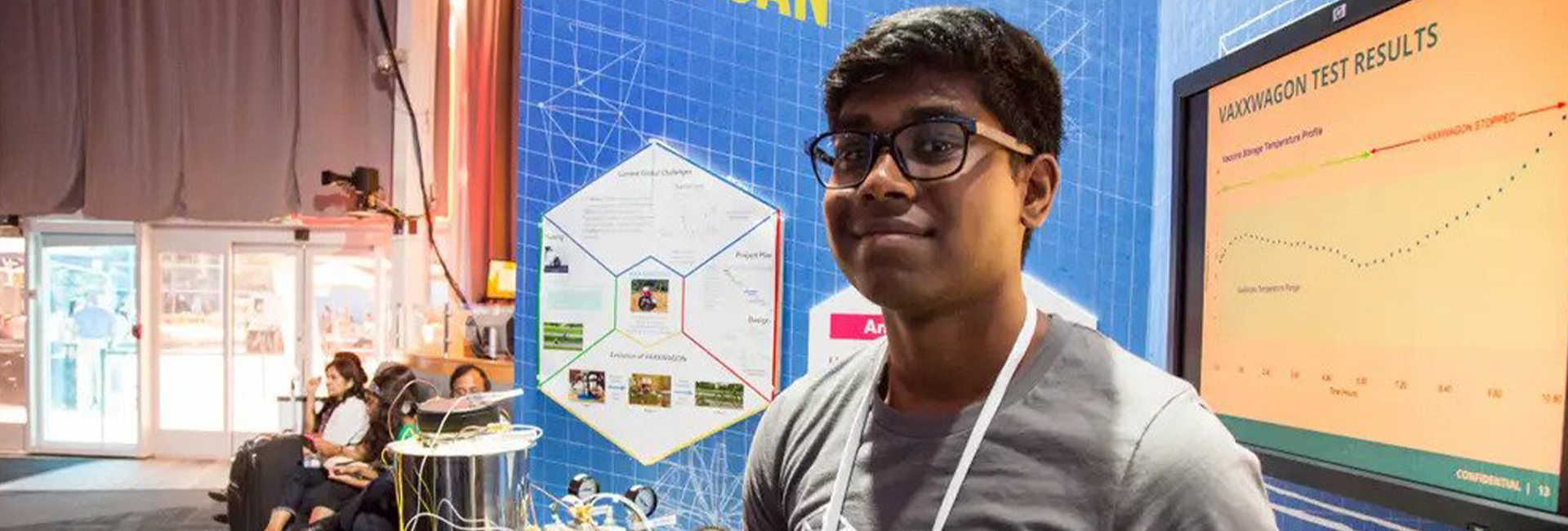(January 16, 2024) A regular crisp afternoon in San Jose, California in 2022 turned into horror when a restaurant burned down to ashes after a fire incident. The then 12-year-old Shanya Gill saw the tragedy unfold in the restaurant behind her home, which left her unsettled. Despite the smoke detector, the restaurant officials were able to raise an alarm only after considerable damage was done, and despite incessant efforts to control the situation, the fire ended up engulfing the entire restaurant. The incident shocked the entire neighbourhood but on Shanya it left a lasting impact. A STEM student who’s always looking for possible solutions to world problems, she decided to come up with a rapid-fire detection device – an invention that won her the Thermo Fisher Scientific ASCEND Award. “The tragedy prompted me to create a device that could detect fires at an earlier stage, preventing similar incidents in the future,” she tells Global Indian.

Shanya Gill
The seventh grader at Miller Middle School understood the need for a “more efficient fire detection system”, and came up with a solution that’s more effective than a smoke alarm. “What distinguishes my fire detection device from traditional smoke alarms is that smoke detectors react only when smoke is present, often indicating a fire at a more advanced and dangerous stage. In contrast, my system, relying on code and a thermal camera, detects unattended fires much earlier in their development,” she explains.
It all began a few weeks after the fire. One day while studying she discovered something interesting about thermal cameras – they can show where homes are losing heat in the winter. Curious, she started looking into whether these cameras could find house fires faster than regular smoke detectors and realised that “an early warning” can help save many lives.
A STEM lover
Born in Boston, Massachusetts, her parents – a doctor and a computer scientist- moved to the US in their early 20s for job opportunities. Carving a dream life for themselves in the US, they have been keen to support their daughter in her endeavours. “Their unwavering emotional support has played a crucial role in my journey,” says the teen innovator. Growing up in California, “where STEM opportunities abound”, she was always interested in science and technology. “My passion for these fields solidified through participation in regional science fairs, where I could combine my love for science and building things,” adds Shanya.


The making of fire detection device
But it was the fire at the restaurant in her neighbourhood that nudged her to find a solution. During her research, she stumbled upon statistics that proved that smoke detectors weren’t as reliable as she thought them to be. “This further motivated me to find a solution.” She spent countless hours working on the initial design which turned out to be a failure owing to loopholes in the code. “This setback prompted me to reevaluate my approach and led to my second attempt where I refined the code.” Highlighting a crucial lesson she learnt from the experience, she says, “is the importance of maintaining motivation throughout the process. Celebrating the small victories in my code, no matter how incremental, proved to be a key strategy in overcoming challenges and keeping the project on track.”
It all began when she stumbled upon an online video where a man used thermal cameras to find the loopholes in the heating system in his home. Snubbing it initially as an expensive affair, upon more research, she found that the thermal camera being used was quite cheap. “My idea for an early fire detection system was already known, and seeing this cheap thermal camera allowed me to tie temperature and fires together,” reveals Shanya.


Finally, she came up with a device that has a thermal camera and a Raspberry Pi, “with the latter being coded to evaluate images sent by the camera and determine the fire’s status – whether it is attended or unattended.” Explaining the process, she says, “The device uses temperature and motion(seeing how a part of an image changes temperature) to detect fires and humans, therefore allowing the device to know whether there is a human and a fire in a scene(attended fire) or just a fire in a scene(unattended fire).”
With an impressive accuracy rate in the range of ninety percent, she plans to incorporate AI in her device to eliminate false positives as well as other factors such as pets. “If put in the marketplace, I believe that this device, with improvements, can alert the user of a fire before it becomes a threat, and I believe it can save a lot of lives,” she adds.
International recognition
Shanya, who describes herself as “independent, persevering, and happy”, received top honours in the foremost middle school STEM competition sponsored by Thermo Fisher Scientific and the Society for Science, and won a cash prize of $25,000 for her innovation. Calling it a moment of gratitude, she says, “It instilled confidence in my abilities.”
Imparting a nugget of advice, she asks youngsters “to stick to your passions and to undertake a long-term project because that teaches you a lot.” The Indian-American teen is a champion swimmer, water polo, and table tennis player, and aspires to be self-employed and invent new things. “I feel this gives me the ability to be creative and not be trapped in a box,” she signs off.
- Follow Shanya Gill on LinkedIn






